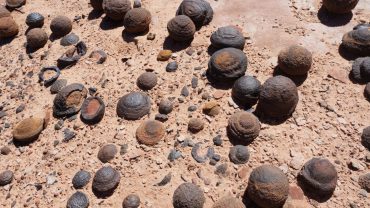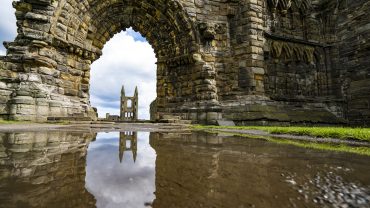Legend attributes their creation to a great flood. In 1841, while leading the United States Exploring Expedition, Charles Wilkes thought they might be burial sites. And we’ve not even touched on the gopher hypothesis yet. Yes, theories abound as to the origins of the Mima mounds in Washington State.
These intriguing earthen landforms, predominantly found in the Mima Prairie, are not just a physiographic feature but a source of mystery and fascination. With their unexplained origins and distinctive appearance, the many mounds of Mima have captured myriad imaginations over the course of centuries, inviting a plethora of theories and speculation about their formation.
So, has the Mima mystery been solved? That’s what we’re here to explore.
What are the Mima Mounds?

Mima Mounds Information Centre (Credit: Tacoma News Tribune / Contributor via Getty Images)
The mounds of Mima in Washington State are a landscape of neat circular earthen mounds that cluster together, giving the impression of goosebumps. Each mound is a pile of sediment such as sand, silt, and rock and measures roughly two to seven feet tall by eight to 40 feet in diameter.
Despite being irregularly spaced and of varying sizes, they seem remarkably uniform. Certainly, the rounded shapes of the mounds help to bolster this perception, their striking symmetry making them look almost artificial.
The term “Mima mounds” refers specifically to the landforms found in the Mima Prairie in western Washington’s Thurston County. The prairie’s name is thought to derive from one of several languages, possibly being Chehalis for “newness,” or Chinook, translating as “downstream” or “a little further.” Whatever the case, “Mima” has become synonymous with such a strange bumpy landscape.
Nevertheless, it’s not the only place in the world, or even in the Pacific northwest of the US, where similar landscapes exist. Examples include the heuweltjies or “small mounds” of South Africa, California’s “hogwallows,” and the “pimple mounds” of the south-central US. These and others bear a strong visual resemblance to the Washington mounds, but may have completely different origins.
Scientific Investigations

Mima Mounds in Washington State (Credit: dschreiber29 via Getty Images)
Over the years, the Mima mounds have been the subject of numerous scientific studies. Researchers from geological, ecological, and other backgrounds have examined these landforms to unravel their secrets. Key findings suggest a combination of natural factors at play, ranging from soil composition to the action of water and wind. However, these studies have yet to provide a definitive explanation for the mounds’ formation.
Mima Mound Theories

Mima Mounds Natural Area Preserve in Washington State. (Credit: randimal via Getty Images)
It’s generally accepted that the Mima mounds formed sometime in the last 16,500 years, after the last Ice Age glaciers started retreating. Beyond this, there’s little consensus as to their origins, with at least 30 well-documented but unproven theories in play. Let’s explore some of the most popular.
The Gopher Hypothesis
Gophers. That’s who many eminent scientists claim made the Washington mounds. This theory, around since the 1940s posits that these go-getting rodents moved into the prairie after the glaciers receded. And that the piles are those typically found atop their nest chambers made up of the soil and pebbles displaced in the process of digging them. What’s more, the spacing of the mounds accords with the territorial nature of gophers, which compels them to keep their nests a few feet apart.
The Sun Cup Hypothesis
The sun cup hypothesis was put forward by J Harlan Bretz in 1913. The glacial geologist believed that the sun melted holes or “sun cups” in the glaciers. And, as water flowed over them, it left behind a variety of debris which collected and compacted in these cups. When, finally, all the snow and ice were gone, the contents of the cups remained, forming the mounds of Mima.
The Seismic Hypotheses
In 1990, geologist Andrew Berg proposed that the Washington mounds may have been formed from the vibrational shock waves of earthquakes moving through the soil. According to his hypothesis, the soil would disperse or accumulate depending on the locations of these waves.
Fluvial Deposition Hypotheses
Fluvial deposition is the process whereby sediments are transported and deposited by rivers and streams. There are several versions of this theory in relation to the Mima mounds. One involves the glacier-dammed Lake Carbon, an Ice Age lake which, when it existed, was located northwest of Mount Rainier. The theory goes that it flooded, its waters sweeping away volcanic rock from Rainier and its surroundings and leaving them behind in mounds in the area that would become the Mima Prairie. A variation on this theme has it that the mounds in Washington State show the routes of where flood water flowed around plants.
These theories don’t stray all that far from the folklore of the Upper Chehalis Tribe. One of their legends tells of a girl who refused to wash her face, fearful that doing so would cause a natural disaster. And that, when she finally did, a great flood covered the earth, transforming it from flat to its mounded state. One version of this story says that the bumps are the remains of sea creatures forced on land when the waters rose.
The Permafrost Hypothesis
This explanation suggests that frozen ground at the edge of the glacier cracked into many-sided shapes, where ice then formed wedges. As the climate warmed and the ice melted, the soil was left in mounded shapes.
The Mountainous Mima Mystery

Mima Mounds Natural Area Preserve (Credit: zrfphoto via Getty Images)
To this day, the Mima mounds in Washington State remain one of nature’s most fascinating enigmas. Despite extensive research over the centuries, the Mima mystery is alive, well, and open to ideas.












